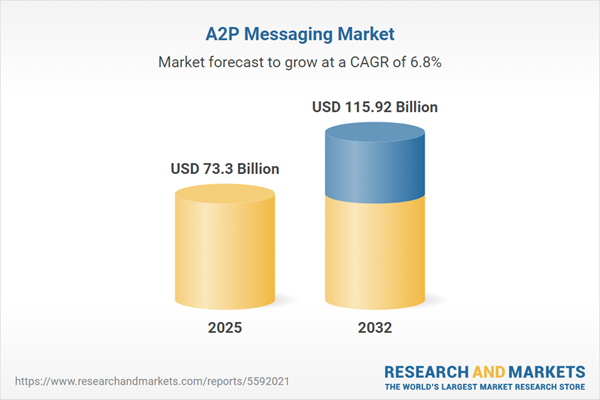Speak directly to the analyst to clarify any post sales queries you may have.
The Application-to-Person (A2P) Messaging Market is transforming business communications by enabling secure, targeted, and regulatory-compliant interactions with customers across multiple industries. Organizations are accelerating digital transformation through advanced messaging strategies, driving competitive advantage and operational efficiency.
Market Snapshot: Advancing Application-to-Person Messaging
The A2P Messaging Market grew from USD 68.64 billion in 2024 to USD 73.30 billion in 2025. It is expected to continue growing at a CAGR of 6.76%, reaching USD 115.92 billion by 2032. Demand is driven by the integration of agile messaging platforms, advancing API-driven services, and expanding regulatory requirements across critical sectors such as banking, healthcare, and retail. Organizations seeking to enhance real-time communications and precision targeting are leveraging rich media, conversational AI, and automated workflows to exceed customer expectations and maintain compliance in a complex, digital-first environment.
Scope & Segmentation: Comprehensive Market Coverage
- Messaging Channels: Multimedia messaging services (MMS), rich communication services (RCS), SMS (authentication—one-time passwords, account alerts; promotional; transactional—delivery notifications, transaction alerts), and voice messaging.
- Applications: Authentication (one-time passwords, two-factor security), customer service (feedback, support chat), marketing (customer surveys, promotional offers), and notification (alerts, reminders).
- Industry Verticals: Banking, healthcare, retail, telecom, and travel.
- Enterprise Sizes: Large, medium, and small enterprises.
- Deployment Models: Cloud (public, private), on-premises (full and hybrid deployments).
- Pricing Models: Licensing (perpetual, term), pay as you go (per message, per seat), and subscription (annual, monthly).
- Regional Segments: Americas (North America: United States, Canada, Mexico; Latin America: Brazil, Argentina, Chile, Colombia, Peru), Europe, Middle East & Africa (Europe: United Kingdom, Germany, France, Russia, Italy, Spain, Netherlands, Sweden, Poland, Switzerland; Middle East: United Arab Emirates, Saudi Arabia, Qatar, Turkey, Israel; Africa: South Africa, Nigeria, Egypt, Kenya), Asia-Pacific (China, India, Japan, Australia, South Korea, Indonesia, Thailand, Malaysia, Singapore, Taiwan).
- Company Analysis: Twilio Inc., Sinch AB, Vonage Holdings Corp., Infobip Ltd., MessageBird BV, Route Mobile Ltd., Tanla Platforms Ltd., CM.com NV, TeleSign Corp., Tyntec GmbH.
Key Takeaways for Decision-Makers
- Strategic adoption of rich communication services, multimedia messaging, and conversational AI is driving higher customer engagement and improved analytics for enterprises seeking advanced messaging outcomes.
- Banking and healthcare sectors are prioritizing end-to-end encryption and secure, compliant messaging frameworks to safeguard sensitive data and maintain trust.
- Segmented approaches—involving channel, application, deployment, and pricing—enable organizations to optimize total cost of ownership and scale solutions to match operational goals.
- Large enterprises demand global reach and full integration, while medium and small businesses prioritize agility, cloud scalability, and low technical overhead through turnkey solutions.
- Leading providers are enhancing their platforms through targeted acquisitions, robust developer toolkits, and partnership ecosystems to deliver extensible, integrated messaging experiences.
Tariff Impact: Navigating 2025 US Policy Shifts
Recent changes in United States tariff policies introduced in 2025 have prompted messaging providers to reassess equipment sourcing and network deployment. Increased costs associated with telecom imports are shaping capital expenditures and prompting companies to foster local partnerships and diversify procurement. This policy shift encourages greater reliance on software-defined networking and localized manufacturing, impacting negotiation dynamics and long-term value chain resilience for service providers and enterprises alike.
Methodology & Data Sources
This report is grounded in a multi-pronged research framework, integrating primary interviews with industry leaders, messaging specialists, and regulatory experts. Rigorous secondary data analysis includes industry reports, regulatory filings, and white papers. Data triangulation and segmentation modeling ensure balanced findings and actionable intelligence for each market dimension.
Why This Report Matters
- Enables senior leaders to benchmark strategies using segmented market intelligence, supporting informed investment in future-ready messaging ecosystems.
- Equips decision-makers with insight on technology integration, compliance resilience, and operational flexibility to optimize platform deployment and customer engagement.
- Offers a clear picture of evolving global and regional dynamics, helping organizations identify emerging risks and competitive opportunities in digital business communications.
Conclusion
Executive teams can leverage this comprehensive research to guide strategic decisions and sustain competitive advantage. Actionable insights and robust segmentation analysis provide a reliable foundation for future messaging initiatives in a dynamic digital landscape.
Additional Product Information:
- Purchase of this report includes 1 year online access with quarterly updates.
- This report can be updated on request. Please contact our Customer Experience team using the Ask a Question widget on our website.
Table of Contents
3. Executive Summary
4. Market Overview
7. Cumulative Impact of Artificial Intelligence 2025
Companies Mentioned
The companies profiled in this A2P Messaging market report include:- Twilio Inc.
- Sinch AB
- Vonage Holdings Corp.
- Infobip Ltd.
- MessageBird BV
- Route Mobile Ltd.
- Tanla Platforms Ltd.
- CM.com NV
- TeleSign Corp.
- Tyntec GmbH
Table Information
| Report Attribute | Details |
|---|---|
| No. of Pages | 195 |
| Published | October 2025 |
| Forecast Period | 2025 - 2032 |
| Estimated Market Value ( USD | $ 73.3 Billion |
| Forecasted Market Value ( USD | $ 115.92 Billion |
| Compound Annual Growth Rate | 6.7% |
| Regions Covered | Global |
| No. of Companies Mentioned | 11 |









